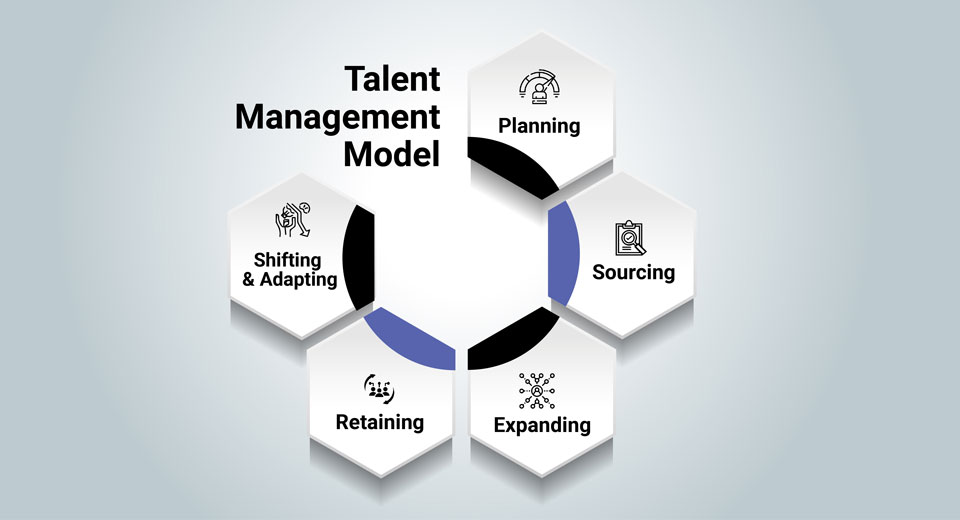
A workforce that is both productive and remains deeply committed to the organization exemplifies a strategically implemented talent strategy. In the present talent-hungry marketplace, HR managers must take precedence in fostering this synergy by not only carefully aligning recruitment processes with the company's long-term goals but also by developing a culture of continuous learning and development.
This blog will cover:
Talent management involves the recruitment, supervision, evaluation, development, and retention of an organization's most vital asset—its workforce. Talent Management is commonly dispersed across various sectors within an organization leading many to grapple with the task of harmonizing these processes into a unified strategy.
While it might appear evident, it's essential to clearly elaborate on the reasons why effective talent management is incredibly important:
Organizations today are well aware of the fact that recruitment decisions made in haste will impact the long-term success and stability of the company. There is a need to focus on the three R's: right people, right skills, and right jobs, and to avoid talent crunches. A proper talent management process aids organizations in welcoming employees with the correct skill set and experience that aligns with the purpose of the assigned job role.
Organizations do not adhere to a standardized talent management model; however, HR managers have established a basic structure as outlined below.

There are five primary categories of situations that require attention in talent planning:
Human resource managers must provide clear guidelines for each situation, outlining actions, and responsibilities. Integrating these protocols into the talent plan allows for proactive workforce management, talent optimization, and the development of a culture of continuous improvement.
Sourcing talent goes beyond mere employee replacement. Talent management ensures a consistently staffed workforce, mitigating demoralizing workloads amidst shifting demands and evolving responsibilities. Creating an effective strategy draws in driven, adept individuals eager to advance within the organization. It revolves around establishing the company's image as an employer of choice, amplifying visibility to position it as an attractive workplace, and ultimately enhancing accessibility. Even when specific positions remain unfilled, providing a positive experience opens doors for potential future hires or utilizing individuals as talent ambassadors.
Talent management is more than just keeping the status quo. Organizations should place a premium on skill development and provide opportunities for people to diversify their skills. Cross-training, workshops, mentoring, and access to online learning platforms can all be part of this. Organizations generate a versatile workforce capable of tackling new challenges and reacting to changing business trends by encouraging people to broaden their skill sets.
Retaining top talent is a critical aspect of talent management. HR managers must identify their high-potential employees and implement strategies to keep them engaged and motivated. This can include personalized career development plans, competitive compensation packages, recognition programs, and a supportive work environment. By investing in the growth and satisfaction of top performers, organizations reduce turnover and maintain a pool of experienced and skilled employees.
Talent management should be flexible enough to accommodate changes in business strategies, technology, and market dynamics. HR managers need to assess the organization's talent needs regularly and be prepared to shift resources and strategies accordingly. This might involve reallocating employees to different roles, retraining teams to meet new demands, and even restructuring departments to optimize talent utilization.
A successful talent management strategy should be harmonized with the organization's objectives and should encompass the specific type of employees as outlined by the Talent Management model. Organizations can emphasize the following steps to effectively execute such a strategy.
Examining a few case studies will enhance comprehension of the previously mentioned steps.
In an eye-opening case study, Avon, a global leader in the beauty and personal care sector, based in London, gave its talent management a makeover – beefing up leadership programs, weaving in hearty mentorship schemes, and hitting the bullseye with pinpoint training. The result? Avon not only kept its top talent on board but also brewed up a storm of creativity and teamwork. This full-spectrum strategy is a testament to Avon's rock-solid pledge to nourish a dynamic company culture that cherishes its employees as gold. The company's special direct-selling method, led by independent reps, echoes its mission of adding a personal touch and creating a sense of community while offering a diverse range of beauty and personal care products.
Starbucks, the cream of the crop in the coffee world, shines with its exceptional talent strategy. They invest in baristas, providing thorough training for top-tier customer interactions and product expertise. Exclusive perks, spanning partner discounts to unconventional medical coverage, are extended to both part-time and full-time employees. These practices cultivate robust bonds, boosting motivation and acknowledgment while curbing turnover. Starbucks' standing as a sought-after workplace, not just run-of-the-mill, speaks volumes of these efforts.
While an HR department is important for workforce management, including recruitment and compliance, it does not fully cover talent management. This encompasses strategies for attracting, developing, and retaining high-potential employees. A tailored approach is essential for a competitive edge and talent retention.
Q. What is talent management in HR?
A. Talent management focuses on growing the skills of the organization's people and highlights using company strategies well to make the most of the talent available.
Q. What is a talent management system?
A. Talent Management System (TMS) is software used by HR and managers to handle employee tasks from hiring and training to performance and growth, all in one convenient place.
Q. What is a talent management framework?
A. A talent management framework is a well-organized plan made up of different steps that work together to help a company do its best. These steps fit together like puzzle pieces to create a system for managing talents, which each organization can customize to fit its own style.
Q. What is the difference between talent management & talent development?
A. Talent management involves a wider range of practices, such as recruiting, onboarding, retaining, and developing employees to fully energize their abilities and enhance their contribution to the organization. Talent development specifically concentrates on aiding employees in learning, growing, and improving their skills gradually.
Q. What are the best talent management practices?
A. Talent management best practices include:

CredBadge™ is a proprietary, secure, digital badging platform that provides for seamless authentication and verification of credentials across digital media worldwide.
CredBadge™ powered credentials ensure that professionals can showcase and verify their qualifications and credentials across all digital platforms, and at any time, across the planet.

Please enter the License Number/Unique Credential Code of the certificant. Results will be displayed if the person holds an active credential from TMI.